# Delivery / Ground / Tower
# Pushback and Taxi
Ground/Apron is responsible for pushback and all taxi guidance at the airport. Ground and Apron differ in that in reality ground is managed by DFS and apron is staffed by the airport operator itself. In Germany, there are six airports with an apron station: Berlin, Dresden, Erfurt, Frankfurt, Hamburg and Munich. The respective areas of responsibility are regulated in these airports’ SOPs.
Taxi guidance on the ground should not be underestimated, as it requires a great deal of attention and foresight, depending on the airport!
### Pushback
As aircraft cannot taxi backwards, they usually have to be pushed back from the parking position onto a taxiway by a tug (tow truck). In some cases, there are also parking positions where the pilot can taxi out under his own power (taxi out positions). Details on that may be outlined in the airport's SOPs.
As a rule, the pushback pushes onto a taxiway. If there are several options for the pushback, the controller must inform the pilot which option will be performed. Most frequently, the taxi clearance specifies the direction the aircraft should face after the pushback (e.g. “facing west”). Differing taxiways can also be specified (e.g. a taxiway that is not directly behind the gate or, if available, a blue/orange line). The controller should already have a plan for the subsequent taxi guidance before the pushback in order to work as efficiently as possible.
| Station | Phraseology |
| **Pilot** | München Apron good day, DLH5KC, stand 205A, request pushback. |
| **ATC** | DLH5KC, München Apron good day, pushback approved, facing south. |
| **Pilot** | Pushback approved, facing south, DLH5KC. |
Please note that a taxiway will be blocked by a pushback for several minutes (varying depending on aircraft type and pilot). For this reason, it is particularly important to keep an eye on the entire taxiway and to work proactively, especially at large airports.
If the pushback is not possible immediately (e.g. because there is already an aircraft behind it or an inbound has to be waited for), the pilot must be informed of this with a “hold position” and, ideally, a brief information on what he still has to wait for. If there are two waiting outbounds on the frequency that are both ready for the pushback, it may also be advantageous to deviate from the "first come, first serve" principle, depending on the situation, if this can reduce the overall waiting times.
### Taxi
After the pushback has been completed and the pilot reports that he is ready to taxi, he is usually guided to the holding point of the departure runway or, at some airports, up to the transfer boundary between the areas of responsibility of tower/ground and apron. As a rule, the pilot may not deviate from the yellow taxi guidelines. Exceptions, if any, are regulated in the respective SOP.
The pilot may also be given taxi clearance if there is another aircraft in front of him which is not yet ready to taxi. The pilot must stop behind it and will only continue taxiing as soon as the aircraft in front moves. With very complex taxi guidance, it is helpful to divide the route into several sections in order to simplify and accelerate the pilot's readback and minimize the risk of errors.
*[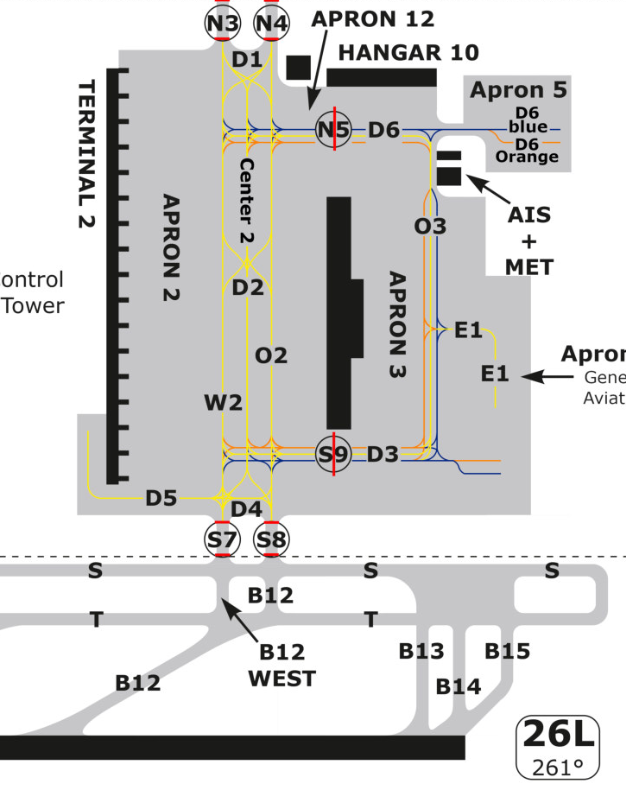](https://knowledgebase.vatsim-germany.org/uploads/images/gallery/2022-10/atd-taxi-eddm.png)
Groundlayout München EDDM*
Depending on the traffic situation, hold shorts or give way instructions (see below) must be used to resolve possible conflicts on the ground. If it can be assumed that two aircraft are not in conflict with each other despite crossing taxiways (e.g. due to sufficient distance), no such instruction needs to be given. However, the situation must be monitored continuously and action needs to be taken if necessary.
The same applies to inbounds. They are handed over from the tower to ground/apron in time before the handover limit and then receive their taxi instruction to the planned parking position.
| Station | Phraseologie |
| **Pilot** | DLH5KC, request taxi. |
| **ATC** | DLH5KC, taxi to entry S8 via W2 D2 O2. |
| **Pilot** | Taxi to entry S8 via W2 D2 O2, DLH5KC. |
- Note on taxi clearance: By definition, the phrase TAXI never exists without a following VIA or TO.
- **TAXI VIA** means "taxi along the taxiways/points....". A taxi instruction must also ALWAYS contain a clearance limit. If you start your instruction with TAXI VIA, there must always be a HOLD SHORT in the same instruction that describes up to which point the clearance extends (clearance limit).
- **TAXI TO** means "taxi to...." and thus describes the clearance limit up to which the pilot may taxi. If you start your instruction with TAXI TO, there must always be a VIA in the same instruction describing the route to the pilot.
#### Keeping traffic moving on the ground
- It sounds trivial, but it is very efficient. Once the aircraft are moving, they will be out of your area of responsibility faster than if they are stationary. For every aircraft that has to stop, additional time passes, it has to be called again to continue taxiing and can sometimes be forgotten. If there is a lot of traffic, the frequency can quickly become full. Instead, whenever possible, use “give way”-instructions or adapt the routing on the ground.
As an ATCO controlling a ground station, you should regularly scan your ground layout: Is a plane about to stop unnecessarily? This should be avoided.
#### Hold Short
Hold short calls are used to stop rolling traffic before a certain taxiway. It should be noted that further taxi guidance is canceled after the hold short. If the aircraft is to continue taxiing, it must be informed (again) of the complete further route. If it is probable that the aircraft will have to wait at a certain point, it should only be given the necessary taxi routes to get to this point.
| **ATC** | TUI4PH taxi to holding point runway 18 via L N1 N, hold short of N5. |
| **ATC** | TUI4PH continue taxi via N. |
| **ATC** | RYR1ME taxi to holding point runway 24 via B A A3, hold short of runway 14L. |
If you want a sequence of taxiing aircraft to stop at a certain point, it is sufficient to give the first aircraft the hold short. All subsequent aircraft will inevitably have to stop behind it. However, it is important to note that as soon as the first aircraft rolls again, the entire sequence will start moving again.
If the route to the active runway leads across another runway (e.g. in Cologne and Hamburg), explicit clearance is always required to cross this runway. If the runway is outside your own area of responsibility, a hold short must be instructed.
#### Give Way
Another way to resolve potential conflicts on the ground is to use the give way instruction. Here, the pilot is given the task of giving right of way to other taxiing traffic. It is important to tell the pilot where he has to let the other aircraft pass (‘at D3’), what other traffic he has to watch out for (company / Lufthansa A320) and where the traffic is coming from. To avoid misunderstandings, only the direction from which the other traffic is coming should be indicated, not where it is taxiing to.
| **ATC** | DLH5KC give way to company A320 crossing right to left on D3.
|
- #### Use ground status and label hold shorts
- Ground status labels are very helpful for keeping an overview yourself, but also to give other controllers the opportunity to quickly get a situation on the ground. They should especially be used when there is a lot of traffic and many controllers simultaneously work at the airfield with different lists.
In this context, it is also advisable to label given hold shorts as tower or ground when there is a lot of traffic. This reduces the risk of forgetting the aircraft in front of an intersection, as the hold short appears quite prominently in the third line of the label.
#### Intersection Departure
On Vatsim, traffic is usually distributed by ground or apron to the various intersections (taxiway junctions) of the runways. Ideally, the pilot reports which intersection he can take off from when he is ready to taxi or during the initial call for further taxiing.
| **Pilot** | München Ground hallo, DLH5KC Entry S8, able B12. |
| **ATC** | DLH5KC, hallo, taxi to holding point runway 26L, intersecton B12, via B12. |
| **ATC** | DLH5KC, hallo (no benefit), taxi to holding point runway 26L via S and B13. |
If it benefits the tower’s departure sequence or the pilot (e.g. time saving), an intersection departure can be assigned. However, there is no obligation to do so, so the pilot can also continue to the beginning of the runway as normal. It is always safer for a pilot if they have more runway available. If they have to wait longer for take-off due to landing traffic, wake turbulence or generally due to the take-off sequence, this time should also be used to taxi on to the start of the runway.
If the use of an intersection is not part of the published standard procedures of an airport (AIP), the pilot must always be asked beforehand whether he can use the intersection. Details can be found in the respective SOP of the airport.
| **ATC** | DLH5KC, advise able to depart from runway 26L, intersection B10.
|
As a ground/apron controller, you should also always take care not to block your main taxiways by assigning the same intersection if you do not know the departure sequence of the tower (e.g. taxiway L in Frankfurt). If in doubt, you should coordinate with the tower or give a handoff as early as possible so that the tower can take the aircraft into the intersection itself if necessary.
####
#### Changed taxi guidance
The traffic situation on the ground is constantly changing, especially at large airports. For this reason, a potential conflict on the route given to the pilot can arise while they taxi or longer waiting times may become necessary, for example due to a pushback. In this case, the controller can change the route of the aircraft on the ground in addition to the already known instructions.
| **ATC** | DLH5KC revision, continue via W2, hold short of D4. |
#### Handover of aircraft
When does the handover of an aircraft between two ground stations actually take place?
In short: hand over your aircraft when you no longer need them. More precisely: Pilots should be handed over to the next position once:
1. ...they have clearance up to the handover point to the next station (in Nuremberg up to the holding point, in Munich on Apron up to entry)
2. ...they are **conflict-free** (i.e. there are no unresolved intersections with other aircraft)
3. ...you do not have to give them any further instructions
If all three points are fulfilled, it’s time for: Contact XYZ Ground/Apron/Tower on 1xx.xxx.
In any case, unnecessary stops for the aircraft should be avoided because of you forgetting to hand them over to the tower, for example. Here too, the airport should be scanned regularly to see if any aircraft can be handed over.
### Advanced Taxiing
Especially when there is a lot of traffic on the ground, it is important to work efficiently and keep the frequency load as low as possible. It is important to maintain the flow of traffic, reduce unnecessary waiting times and radio messages (few hold shorts, short and concise instructions, early handoffs) and still ensure safety. Here are a few tips that can make your work easier.
*NOTE: Only use these procedures if you feel comfortable with them and can handle them! It is also always possible that a pilot may not understand your instructions exactly and will not ask you.*
#### Push and Pull
It doesn't always have to be the classic push back, especially pilots with X-Plane are easily able to pull forward and disconnect the tug at a certain point. This is useful, for example, when two aircraft are pushing next to each other or you want to clear the taxiway for another aircraft in a timely manner.
| **ATC** | DLH123, pushback approved, then pull foreward, disconnect (tug) short of D2 / abeam stand 217. |
#### Conditional Pushback
Just like Give Way instructions, conditional pushbacks can transfer responsibility to the pilot. This is particularly useful if an outbound pilot has to wait for another aircraft that must first pass behind him. It is always important to ensure that the instruction is unambiguous and cannot be misinterpreted.
| **ATC** | DLH123, when clear of outbound company A320 behind, pushback approved. |
| **ATC** | DLH123, when space permits, pushback approved. |
| **ATC** | DLH123, when clear of the inbound British Airways A319 for V117, pushback approved, orange line, facing west. |
#### Intersections First
Aircraft leaving or crossing a runway should be prioritized if possible. This way, tower can allow aircraft to cross the runway more efficiently and with less waiting time for outbounds.
| **ATC** | DLH123 give way to the vacating Condor A320 from runway 25C. |
| **Pilot** | Giving way to the vacating traffic, DLH123. |
| **ATC** | CFG789 number one, taxi right via L, hold short of N8. |
#### Give Directions
If you need to move quickly or if the pilot is not familiar with the airport, it is always helpful to tell the pilot whether he should turn left or right onto a taxiway (left, right, straight ahead).
| **ATC** | DLH123, taxi right on L, hold short N8. |
### Backtrack
The term "backtrack" (German: *Zurückrollen*) refers to a procedure in which an aircraft enters a runway from an intersection and then moves in the opposite direction of the runway, proceeding along the runway to the beginning. There, the aircraft turns around so that it can take off from the full runway length. This procedure is particularly used when there is no designated taxiway leading to the runway beginning, or when the taxiway is not approved for certain aircraft types.
It is important to note that during this time, the runway cannot be used for other flight operations (takeoffs/landings). Therefore, the next approaching aircraft should be considerably farther away than during a "normal" lineup, depending on how long the backtrack procedure takes. Details regarding this can be found in the SOPs of the respective airports.
| Backtrack |
| **English** | **German** |
| DLH5EJ, backtrack approved, line up runway 03 | DEEZU, Zurückrollen genehmigt, rollen Sie zum Abflugpunkt Piste 03 |
# Priorities - Ground & Tower
In order to ensure safe and smooth flight operations, it is important to work efficiently and safely. It is important to always **work proactively** and not fall behind the traffic. This includes looking beyond your own area to see what your colleague in the neighboring position is doing, for example.
Setting the right priorities is therefore essential for the safe and efficient handling of air traffic. This helps the controller to focus and maintain control of the airport. The following priorities should be used as a guide:
1. Emergencies
2. Flying traffic (take-off and landing clearances)
3. Runway Clearances (line-ups / unway crossings)
4. Taxiing traffic (avoid stopping anywhere unnecessarily)
5. Pushbacks
6. Startup/Enroute clearances
7. Miscellaneous
In short, remember: "Flying before taxiing before standing".
Priorities are particularly important for time-critical instructions where a few seconds can be crucial (e.g. landing clearance on short final). These priorities also help to ensure your own efficiency, a good use of the airport’s capacity and to avoid frequencies that are too full.
##### Giving and labeling standbys
When there is a lot of traffic, for the reasons mentioned above, it is no shame at all if the less important things such as enroute clearances are put on standby for a few minutes. In cases like this, you can say something like "DLH123, standby, number 2 for clearance" to the pilot. A standby can also be useful for other reasons, e.g. because the pushback cannot yet be given due to other traffic: "DLH123, standby for pushback due to traffic".
To keep an overview of which aircraft have been given a standby, you can use the request column in the startup or departure list, at least for the outbounds, to highlight standbys so that you don't have to remember them. If, for example, a plane calls in for pushback or enroute clearance and this cannot yet be given for whatever reason, you go to the corresponding line, click on the REQ column and then go to the fitting clearance. You will then see "R1P" in yellow, for example. The "R" stands for request, the number for the number of the aircraft's turn (e.g. 2 if another aircraft before it has the same standby) and the "P" for the type of request (C = clearance, P = pushback, T = taxi, etc.).
Optionally, you can also show the timer column by right-clicking on the "O" in the top left of the list and then activating "Timer". You can then see how long a plane has been waiting.
[](https://knowledgebase.vatsim-germany.org/uploads/images/gallery/2024-03/screenshot-8.png)
Finally, you should get into the habit of checking the REQ column regularly so you never forget standbys again.
# Tower Efficiency
- #### Optimizing the departure sequence
- A crucial point where many valuable seconds may be wasted, is the take-off sequence. Especially when there are a lot of traffic and narrow gaps, it is important to get the traffic into the air as quickly as possible.
Try to get as close as possible to the minimum separation between departing aircraft to avoid creating unnecessarily large gaps. If you wait just one minute too long, for example, you have reduced the airport’s departure capacity of up to 50%. In order to enable efficient spacing, it may also be necessary to adjust the departure sequence so aircraft do not take off in the order in which they called the tower. At many airports, various intersections can be used for this purpose. Gaps on the frequency can be used for conditional line-up clearances.
It may make sense to deviate from the "first come, first served" principle for the following reasons:
**Wake turbulence separation**
[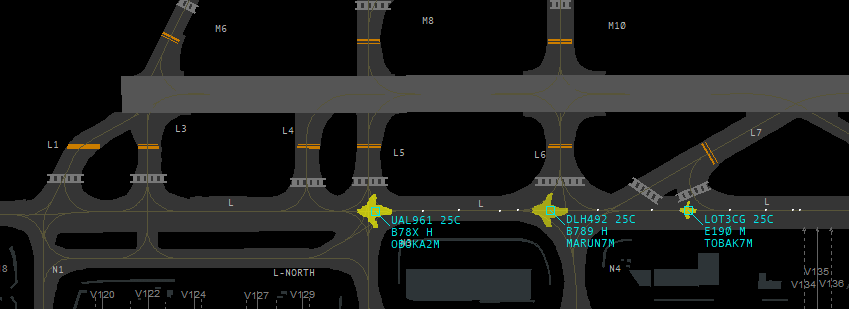](https://knowledgebase.vatsim-germany.org/uploads/images/gallery/2024-03/screenshot-5.png)
In the picture we have the following constellation: A heavy is taxiing to the runway at the front, followed by another heavy and a medium at the end. If the planes now take off in this order, you need 4 NM between the first two heavies and 5 NM between the second heavy and the medium. This makes a total of 9 NM.
However, if we now prefer the medium and let it take off from intersection L4 as number 1, for example, we only need 3 NM between the medium and the first heavy and 4 NM between the two heavies again. This makes a total of 7 NM. This means we have saved 2 NM directly - that's just under a minute.
Conclusion: If the medium and heavy arrive at the runway at relatively the same time, you should try to give preference to the medium in order to generate the lowest average delay. You should act sensibly though and not let a heavy wait for several minutes just to get a few mediums out first.
**Mixing different SIDs**
As you learned in the [tower separation](https://knowledgebase.vatsim-germany.org/books/practical-procedures/page/tower-separation "Tower Separation") article, you usually need 5 NM of separation between aircraft on the same SIDs. With different SIDs, 3 NM radar separation is sufficient.
Suppose you have a situation in which, for example, two aircraft with the same SID are taxiing north to the runway and behind them an aircraft with a different SID is taxiing south to the runway. If you now give takeoff in this order, you need 5 NM between the same SID departures and 3 NM between the north and south SIDs.This means a total distance of 8 NM. However, if you now place the aircraft with the south SID between the two north SID departures, you only have to wait 3 NM in each case, which results in a total distance of 6 NM. This means that one aircraft has to wait a little longer, but another can get out much faster and you have saved an average of 2 NM and therefore also time.
**Big performance differences**
Assuming you have a C172 IFR waiting at an intersection and a Boeing 777 at the beginning of the runway. You learned above that you should try to avoid wake turbulence. So do you now pull the C172 in front of the B777? If you did this, the B777 could of course take off 3 NM behind the C172, as we only need the radar separation. But in this case, the performance differences are so great that the B777 will have caught up with the C172 within a few seconds, both in terms of speed and altitude. This means that, despite the initial separation, the aircraft quickly will produce a loss of separation. In such a constellation, depending on when the flight paths of the C172 and B777 separate, it might take several minutes until the C172 has left the area the B777 will initially climb into or is 3 NM away from the SID of the B777, ensuring separation.
In such a case, it makes more sense to let the B777 take off first and have the C172 follow with 6 NM wake turbulence separation.
The constellation of the aircraft strongly influences when the performance differences outweigh the wake turbulence separation. In general, it can be said that all jet airliners have a similar performance, at least in terms of speed in climb, whereas props are often significantly slower. However, this does not always apply. If in doubt, it is better to wait a little too long than too short.
- #### Avoid missed approaches
- If there is a risk of loss of separation, the controller must take action. In addition to the option of a [go around](https://knowledgebase.vatsim-germany.org/books/practical-procedures/page/missed-approach-controller-guide "Missed Approach - Controller Guide"), the possible alternatives should also be considered. At international airports (EDDx), for example, speed instructions can be given to avoid loss of separation.
However, if there is another aircraft behind the approach controller, this must be coordinated in advance. [Reduced runway separation](https://knowledgebase.vatsim-germany.org/books/separation/page/reduced-runway-separation-rrs "Reduced runway separation (RRS)") can also be used in appropriate conditions.
#### Handling close situations
A few questions that most tower controllers have certainly asked themselves at some point, including some food for thought (using the example of a 4 km long runway):
**When is the last moment I can clear an aircraft for takeoff while an inbound is approaching?**
Let’s assume that the departing aircraft is already on the runway. A statement in the form of "the takeoff clearance must be given at X NM final at the latest" is difficult, because it essentially depends on two factors:
1. The speed of the inbound in the last part of the final approach (a slow aircraft still takes considerably longer to cross the runway threshold in the 3 NM final than a fast aircraft)
2. The inertia and speed of the outbound (it will take Boeing 747 a few seconds longer from take-off clearance until it actually starts rolling than a CRJ9, for example)
As a rule of thumb, most airliners need approx. 1:05 - 1:15 minutes from the start of the take-off run to flying over the end of the runway on a 4 km long runway. This means that the inbound aircraft should take a little more than 1 minute until crossing the runway threshold to ensure normal runway separation. Reduced runway separation (2,400 m), as may be used in good weather and with appropriate markings, is usually achieved after approx. 45 seconds.
If you now take into account the time between issuing the takeoff clearance and the start of the takeoff run (approx. 3 - 10 seconds), this means that the takeoff clearance for normal runway separation should be given when the inbound still needs a little more than a minute to reach the runway threshold (based on a 4 km runway; for a 3 km runway, you can deduct another approx. 10 seconds). For reduced runway separation (2,400m), it is also sufficient if the inbound will take just under a minute - but this will produce a close spacing, as in the picture below, and it is all the more important to make sure that the outbound actually rolls off.
But how do I know how long the inbound needs from its current position to the runway threshold? There are two possibilities:
1. Calculate: An inbound flying exactly 120 knots GS flies 120 NM / hour, i.e. 2 NM per minute. In other words, it still needs one minute in the 2 NM final. An inbound that flies 150 knots GS flies 150 NM / hour, i.e. 2.5 NM per minute. In other words, he still needs one minute in the 2.5 NM final. Everything in between must then be roughly interpolated in your head based on these calculations
2. Set the speed vector to one minute (in Euroscope via the top toolbar): When the minute vector meets the runway threshold, it will be exactly one minute until the inbound crosses it. The take-off run should have already been started a few seconds earlier for normal runway separation; otherwise you will "only" achieve reduced runway separation.
[](https://knowledgebase.vatsim-germany.org/uploads/images/gallery/2024-03/screenshot-6.png) *According to the speed vector, THA922 still needs 1 minute to reach the runway threshold, i.e. DLH470 must begin its take-off run in the next few seconds so we can maintain reduced runway separation. Normal runway separation is no longer possible, however, as the Thai would still have to be more than 1 minute away.*
*[](https://knowledgebase.vatsim-germany.org/uploads/images/gallery/2024-03/screenshot-7.png) Result: With a buffer of a few hundred meters, we have reduced runway separation (the 2,400m marker is at L14)*
**What if the plane is still at the holding point?**
The time for the lineup must be added to the minimum times mentioned above. This depends very much on the type of intersection (90-degree intersection vs. high-speed turnoff intersection like in EDDM) and also on the type of aircraft. A B748 lines up way more slowly than a small A320. Take a look at the typical lineup times for your airport. In the worst case (sluggish aircraft, 90-degree intersection) this can take around 60 seconds, in the best case (agile aircraft, angled intersection) sporty pilots are in the line-up position after just 20 seconds. The average is somewhere in between. As a result, you can average that if the inbound is still about 2 minutes away from the runway threshold, you can give line-up and takeoff clearance from the holding point if you motivate the pilot accordingly (see below) and usually get normal runway separation. Here, too, you can either calculate or display the 2-minute speed vector to know where the inbound will be 2 minutes out.
**How much separation do I need between two inbounds to get an outbound between them?**
In addition to all the factors mentioned above, there is another factor to consider: the availability and type of runway exits. In such a constellation, the factor limiting the outbound takeoff clearance is usually that the first inbound has to get off the runway first. At airports such as Munich or Frankfurt with many available high-speed turnoffs, under good conditions the time between flying over the runway threshold and leaving the runway is around 45 seconds. Heavy aircraft need slightly longer than 60 seconds. On Vatsim, there is also the factor of pilot quality - if you cannot assess the pilot exactly, you should calculate rather conservatively and assume a runway occupancy time of 1 - 1.5 minutes.
During this time, the outbound pilot will usually already have completed the lineup and can be cleared for take-off. The same rough values apply as explained above.
If you now add the two values - runway occupancy time of the first inbound + time from takeoff to flying over the runway threshold of the outbound, you arrive at around 2 minutes (ambitious) to 2.5 minutes (conservative). This means that the second inbound should still be 2 - 2.5 minutes away from the runway threshold when the front inbound is over the runway threshold. Depending on the wind and aircraft type, this means a **gap of around 5 - 6 NM at touchdown**. Most airport SOPs will therefore recommend take-offs and landings on the same runway to create 6-mile gaps between the inbounds to get outbound between. Now you also know the theoretical background to this.
**How can I increase my chances on the frequency that a close situation works out?**
Luckily, there are a couple of phraseology tools which you may and should use for closer situations:
An inbound shall vacate the runway quickly?
> "DLH4JA, after landing expedite vacating, wind 280 degres, 5 knots, runway 25C cleared to land"
An outbound shall be prepared to depart quickly?
> "DLH3CN, prepare for immediate departure (as soon as runway is clear)"
Thereafter:
> "DLH3CN, wind 280 degrees 5 knots, runway 25C, cleared for immediate takeoff"
There will be an outbound just before the inbound touches?
> "CFG4MA, reduce to final approach speed, expect late clearance, traffic, A320 departing ahead"
- "Reduce to final approach speed" may only be used when there is no traffic behind which would affect separation. Otherwise, this has to be coordinated with the approach controller
- Giving the traffic information is beneficial because in case of Reduced Runway Separation, you have already given the traffic information before
- "Expect late clearance" makes sure that the pilot does not unnecessarily ask for the landing clearances e.g. on 2 NM final
# Not withholding a takeoff or landing clearance
This procedure is not a mandatory part of S1 training.
#### Introduction
Under certain circumstances, a take-off or landing clearance can be issued even if the runway is not clear yet. However, there must be **reasonable assurance** that the **runway will be clear** as soon as the **inbound aircraft crosses the runway threshold** or the **outbound aircraft begins its take-off run**.
This procedure can reduce the frequency load and increase efficiency on the frequency, especially when traffic volumes are high. However, applying it appropriately requires a high level of knowledge and experience.
The crux of the matter is the requirement of "*reasonable assurance*" for a clear runway as soon as the take-off or landing clearance takes effect. Of course the term "reasonable assurance" allows for a wide variety for interpretation. Because flight safety is nevertheless the top priority in all procedures, it is advisable to delete the word "reasonable" from your own mindset if possible and only apply the procedure if there is "assurance" that the relevant conditions will be met at the necessary time.
#### Takeoff clearance
**Situation (A)**: Without the procedure described in this article, I may not issue a take-off clearance at this time, as GREEN has not yet crossed the runway end and the runway is therefore still occupied. But considering "reasonable assurance", a controller can issue the take-off clearance at the time of situation A if they have "reasonable assurance" that GREEN will have already flown over the end of the runway and the runway will be clear when BLUE begins the take-off run. This situation is illustrated in **situation (B)**.
[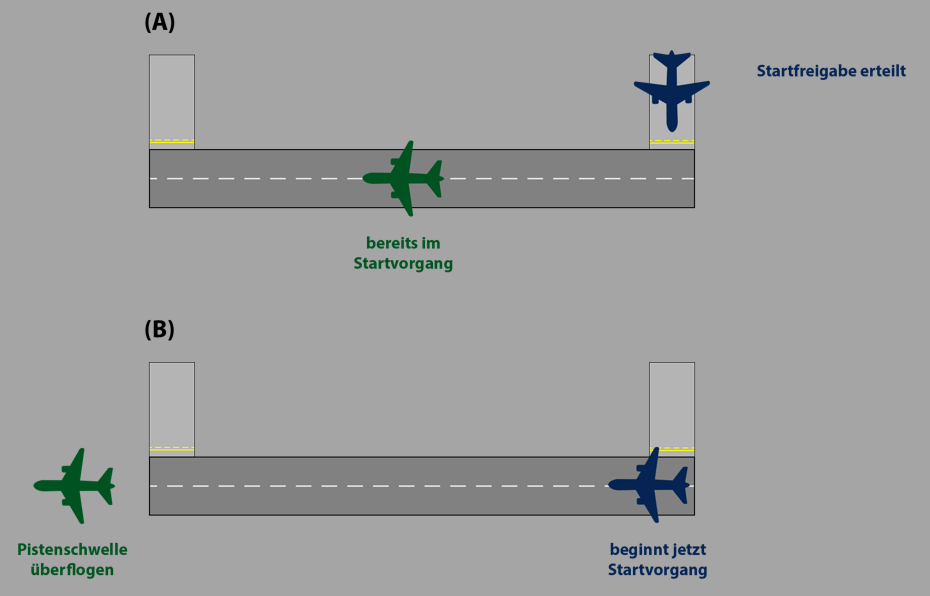](https://knowledgebase.vatsim-germany.org/uploads/images/gallery/2022-11/atd-nichtzuruckhalten-start-v2.png)
This procedure can also be used under reduced runway separation (RRS). Wake turbulence and/or radar separation must still be ensured if necessary.
#### Landing clearance
**Situation (A):** Without the procedure described in this article, a landing clearance would not be possible as the runway is still blocked by the landing aircraft GREEN. As controller, however, I can clear the landing by "not holding back a landing clearance" if I have "reasonable assurance" that GREEN will already have left the runway and the runway will therefore be clear when BLUE crosses the runway threshold. In **situation (B)**, the above has occurred and the procedure has been applied correctly. However, for the reasons mentioned under "Take-off clearance", it is difficult to predict the speed when an aircraft leaves the runway and thus to achieve "reasonable assurance".
[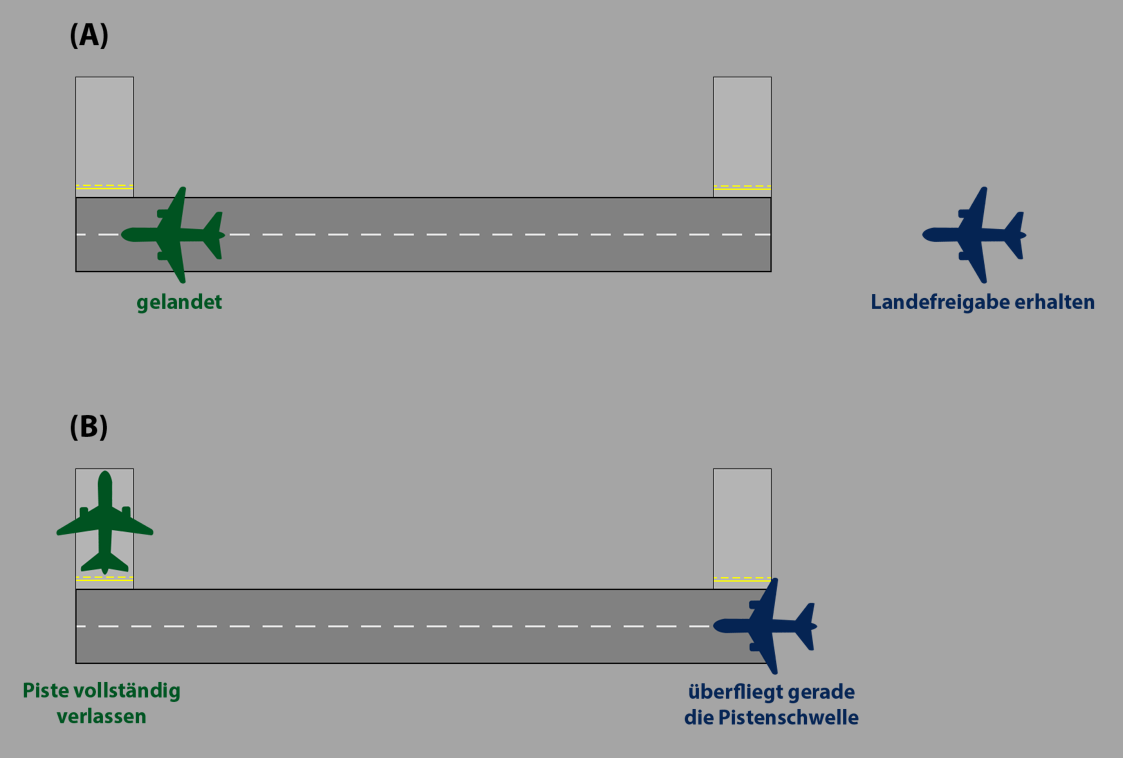](https://knowledgebase.vatsim-germany.org/uploads/images/gallery/2022-11/atd-nichtzuruckhalten-landung-v2.png)
The procedure can also be used if a departure takes place before the landing traffic. Once this has taken off, it is relatively easy to predict with "reasonable assurance" whether the runway will be clear when the approach crosses the runway threshold. In this case, the landing clearance may be given before the departure has flown over the runway end, provided that the runway will be clear when the approach flies over the runway threshold.
This procedure can also be used under [reduced runway separation](https://knowledgebase.vatsim-germany.org/books/separation/page/reduced-runway-separation-rrs "Reduced runway separation (RRS)") (RRS). Wake turbulence and/or radar separation must still be ensured if necessary.
#### Phraseology
The phraseology does not change compared to the "normal" take-off and landing clearances. Traffic information is **not** mandatory when using this procedure. However, as always, traffic information can contribute to better situational awareness on the part of pilots and controllers.
#### Examples
The main purpose of this procedure is to use the frequency more efficiently, especially when there is a lot of traffic, by for example avoiding a second unnecessary radio call.
[](https://knowledgebase.vatsim-germany.org/uploads/images/gallery/2024-03/screenshot-9.png)
Example 1 (see picture): DLH9AX is at the holding point and reports ready. The previous departure is airborne and will have flown over the end of the runway in approx. 10 seconds. Thanks to this procedure, I can give the takeoff clearance directly, even though there is no runway separation at this point. I have reasonable assurance that the runway separation will exist at the time when the following aircraft begins its takeoff run, as certainly there will be more than 10 seconds between the lineup instruction and the start of the takeoff run.
[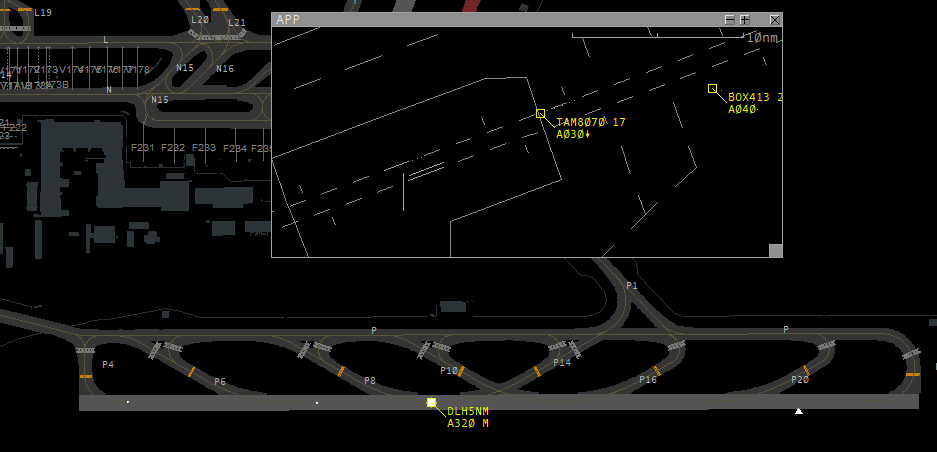](https://knowledgebase.vatsim-germany.org/uploads/images/gallery/2024-03/screenshot-10.png)
Example 2 (see picture): TAM8070 reports on 8 NM final approach. The previous inbound has landed and is slowing down on the runway. Thanks to this procedure, I can give the inbound caller their landing clearance directly with the initial call, even though there is no runway separation at that time. I have reasonable assurance that the runway separation will exist at the time when the following inbound flies over the runway threshold, as it still needs approx. 3 minutes to reach the runway and the leading inbound is about to leave the runway.
Of course, as the controller I still have to monitor the situation and if for any reason the separation is not given, I have to withdraw the clearance.
The procedure should **not be used in close situations** (e.g. if the following inbound is already on short final and the leading inbound has not yet completely left the runway). In this case there is **no** reasonable assurance about the separation at the time of the threshold overflight. Instead, you should delay the landing clearance until the runway has actually been cleared.
# Conditional Lineup
##### Introduction
At all controller stations, it is extremely important to use the frequency as efficiently as possible. In our heads, we may be able to think about and work on two things at the same time, but on frequency, we cannot give two instructions to different aircraft at the same time. This makes it advisable to prioritize transmissions in order to have time for other transmissions later. An ideal option for this is the conditional lineup clearance. It allows you to delegate the clearance to the pilot and instruct him to taxi onto the runway after a certain amount of traffic.
It is important to always tell the pilot exactly which traffic is involved! There must also be good visibility so that the pilot can see the other aircraft. If the weather conditions are poor or the angle of the intersection is unfavorable (more acute than 90°), the pilot must first be asked whether he can see the traffic in question.
As mentioned above, this procedure is intended to make better use of gaps in the frequency and thus increase efficiency. It should be noted that a conditional clearance is significantly longer and takes more time than a standard one. Depending on the traffic situation, a conditional clearance can be significantly more efficient than a normal lineup. If, for example, one can expect that by the end of the call the landing traffic has already flown over the runway threshold or someone else has already started the take-off run, a normal lineup is probably more suitable
##### For departures
When traffic volumes are high, it can be very important on some airports to achieve efficient spacing of departures and not lose any time. To make this possible, the outbounds should start their lineups as soon as possible. Here, the controller can work well in advance and guide the aircraft onto the runway according to their planned departure sequence.
Several conditional clearances at the same time are only possible if the restricting aircraft is the closest aircraft to the restricted aircraft. This is explained further in the example below.
[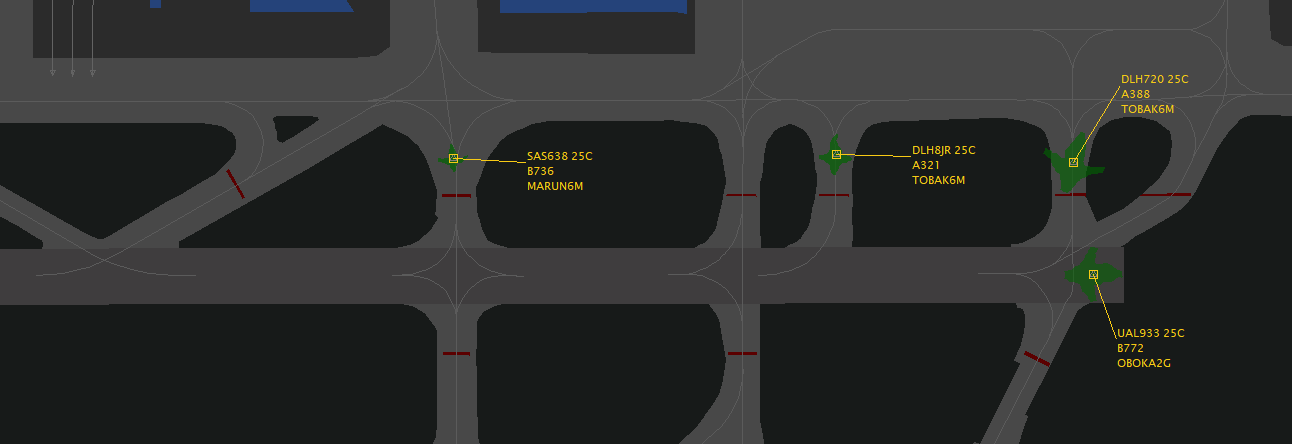](https://knowledgebase.vatsim-germany.org/uploads/images/gallery/2022-10/atd-condinional-lineup.png)
*Example for a conditional lineup in Frankfurt runway 25C (click for full screen)*
| Station | Phraseologie |
| **ATC** | DLH720, **after** departing Boeing 777, lineup runway 25C **behind**, number 3 for departure. |
| **Pilot** | **After** departing Boeing 777, lining up runway 25C **behind**, number 3, DLH720. |
| **ATC** | SAS638, **after** next departing Boeing 777 full length, lineup runway 25C **behind**. |
| **Pilot** | **After** departing Boeing 777 full length, lineup runway 25C **behind**, SAS638. |
The words “after" must be mentioned at the beginning and the word "behind" at the end, this needs to be read back by the pilot! If the pilot is not next in the departure sequence and has received a conditional clearance, he should be informed of this position in the sequence (e.g. number 3 for departure) to avoid misunderstandings.
The airline should not be explicitly mentioned in the description of a restricting aircraft. Due to various leasing agreements and other commercial contracts, Lufthansa flights, for example, are often operated by Air Dolomiti aircraft. In this case, mentioning "Lufthansa" would confuse the pilots, as the relevant aircraft actually sports an Air Dolomiti livery. Instead, the description should be based on the aircraft type and position.
The following instruction would **not** be possible:
| **ATC** | DLH8JR, behind departing company Airbus A380 via L3, lineup runway 25C and wait behind, number 4. |
Simultaneous conditional clearances are only possible if the restricting aircraft is the **next aircraft** taxiing past the restricted aircraft. In this case, the restricting aircraft for the DLH8JR would be the DLH720. However, DLH720 is not the first aircraft to roll past DLH8JR, as UAL933 starts its take-off run first and thus rolls past DLH8JR. The conditions are therefore not met.
##### For approaches
In order to use the gap between two approaches for a departure (see also [Tower efficiency](https://knowledgebase.vatsim-germany.org/books/practical-procedures/page/tower-efficiency "Tower Efficiency")), the lineup needs to take place as soon as possible after the first landing aircraft has crossed the runway threshold. This allows the take-off clearance and take-off run to take place as soon as the landing aircraft has left the runway.
| Station | Phraseologie |
| **ATC** | DLH5KC, **behind** next landing A320 on 2 NM final, lineup runway 26L **behind**. |
| **Pilot** | **Behind** next A320, lining up runway 26L behind. |
As stated before, the airline should not be explicitly mentioned in the description of the aircraft. Due to various leasing agreements and other commercial contracts, Lufthansa flights, for example, are often operated by Air Dolomiti aircraft. In this case, mentioning "Lufthansa" would confuse the pilots, as the relevant aircraft actually sports an Air Dolomiti livery.
The same rule stated above also applies here: Several simultaneous conditional clearances are only possible if the restricting aircraft is the next aircraft taxiing past the restricted aircraft. For example, a conditional lineup behind a landing aircraft may not be issued if an aircraft will still taxi past the waiting aircraft during the take-off run before the restricting landing aircraft.
# Tower Separation
### General
All control towers operated by DFS (German Air Traffic Control) at international airports (EDDx) have a **radar system** that can provide radar separation. This might sound obvious at first glance, but it is not. There are still some controlled airports in Germany, such as Mannheim or Karlsruhe, which either do not have radar or whose air traffic control personnel are not trained to use radar for separation. At these airfields, the conventional approach is separated through timing or the separation between IFR arrivals and departures is delegated to the radar controller above.
Here you can see an example of the air situation radar at Munich Airport (click for full screen):
[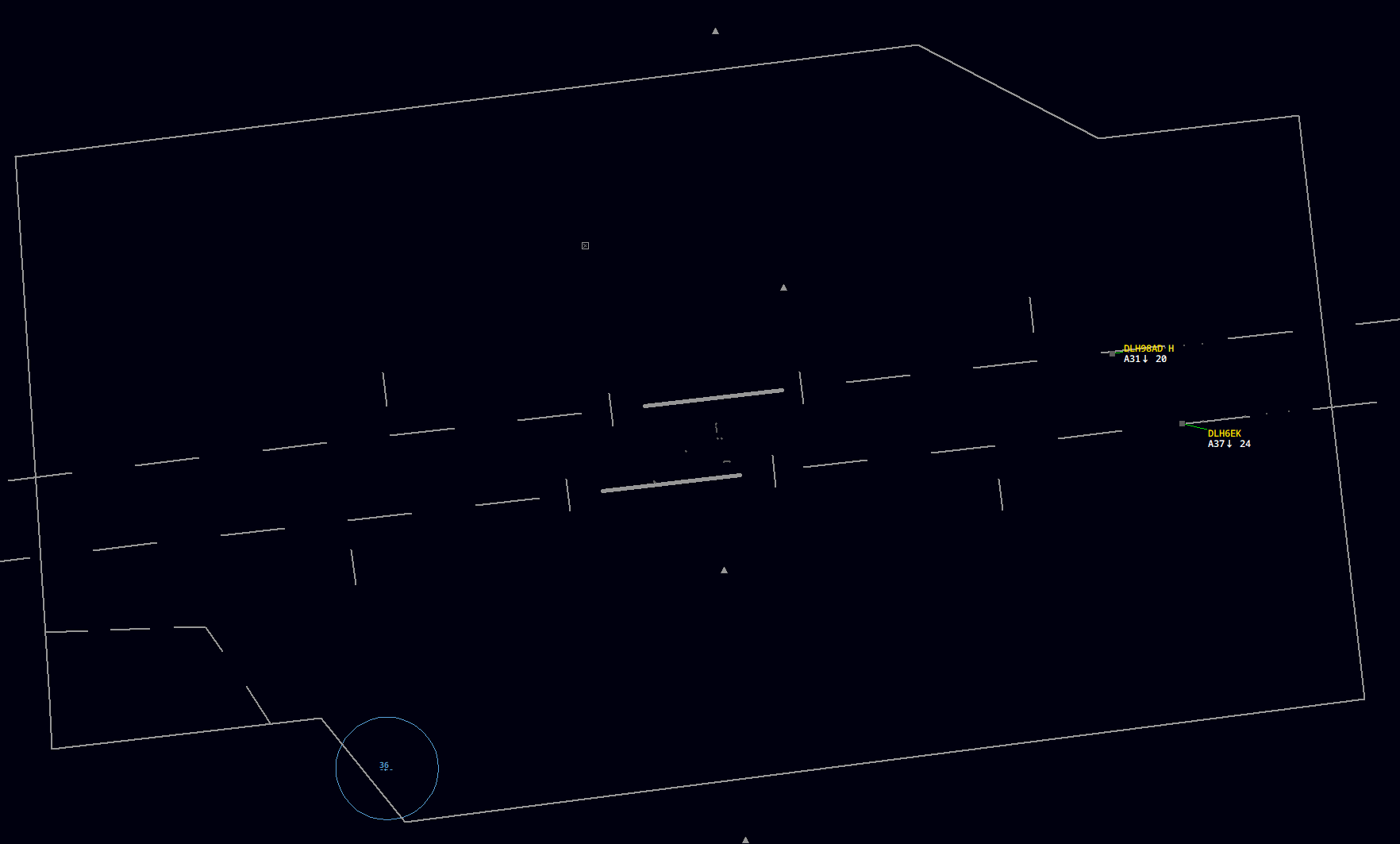](https://knowledgebase.vatsim-germany.org/uploads/images/gallery/2022-11/atd-luftlage-munchen.png)
Here you can see the lateral boundaries of the Munich control zone, you can see the two runways in the middle and dashed lines in their extension, the so-called extended centerlines. Each gap and dash on this extended centerline equals one mile. Among other things, this enables us to measure distances in the control zone and therefore use the radar to create separation. On the final approach to runways 26L and 26R, you can see two radar targets representing two aircraft. Next to the actual radar target you see the so-called label or tag. These two terms describe the information (here: callsign, groundspeed and altitude) provided to the controller by the radar system.
The **basic minimum radar separation** is 5 NM. With appropriate radar technology, this separation may be reduced to 3 NM. In Germany, radar coverage has become good good enough to allow us to operate at **3 NM** separation almost everywhere (with a few exceptions in the Bremen FIR and in the very south over the Alps) below FL245. Consequently, **3 NM is also the minimum value in your control zone** if you have to use radar separation there.
Between which flights do we have to ensure radar separation? To do this, we need to know which airspace class we are in. In the table in the [airspaces chapter](https://knowledgebase.vatsim-germany.org/books/air-law/page/overview), the third column of the table shows us who must be separated from whom. In your airspace as a tower controller, i.e. D-CTR, you **only need to separate IFR flights\***. For example, if a VFR flight approaches an IFR flight at the same altitude to within 1 NM, this is not a "rule violation" in D-CTR. In airspace class C, on the other hand, this would be a "rule violation", as there (as you can see in the table) IFR must also be separated from VFR. This means that the approach controller in airspace C must make sure that every VFR flight is at least 3 NM away from any IFR flight. However, since you are a tower controller in charge of a D-CTR, this is very convenient for you. These "rule violations" connected to separation are called “loss of separation” or LOS (STU or STaffelungsUnterschreitung in German). These LOSes must be prevented at all costs, as they are safety-critical events and usually lead to a failing grade in a practical test on VATSIM.
\*In the 2 training you will also learn that IFR to SVFR (special VFR) must also be separated in the control zone. More information on this in [this ](https://knowledgebase.vatsim-germany.org/books/separation/page/radar-separation "Radar separation")and [this](https://knowledgebase.vatsim-germany.org/books/vfr-AeY/page/special-vfr-svfr "Special VFR (SVFR)") article. However, this is not yet mandatory for S1 training so as not to make it too complex.
### Departures
As a tower controller you are responsible for the take-off sequence and the spacing between take-offs. It will take a while before you develop a feeling for how long you need to wait between two departures to achieve a desired separation.
If you have to separate two departures, you must select the largest value between
- [Radar separation](https://knowledgebase.vatsim-germany.org/books/separation/page/radar-separation "Radar separation") (always 3 NM)
- [Wake turbulence separation](https://knowledgebase.vatsim-germany.org/books/separation/page/wake-turbulence-separation "Wake turbulence separation") (4 - 8 NM)
- Departure Spacing (individual value)
**Radar separation**, therefore, always is the minimum between two IFR aircraft. Depending on the constellation of wake turbulence categories you may also have to keep **wake turbulence separation**. Details on these values can be found in the corresponding article.
But what is **departure spacing**? Sometimes local procedures require more spacing than separation actually prescribes. One example is departures on the same SIDs:
An **additional requirement** for departure spacing most airports require a minimum spacing between consecutive departures on the **same SID** of least **5 NM** (see your training airport's **SOP** for details).
While separation always describes the absolute minimum, spacing is a value that is always at least equal to or greater than the separation minimum and includes an optional safety margin.
In mathematical terms: Spacing = separation minimum + optional safety margin.
The approach or center controller may also specify a departure spacing in individual cases if the airspace is very full. An **MDI**, i.e. **Minimum Departure Interval**, usually expressed in minutes, can also be imposed here. With the restriction "MDI CINDY 5 minutes", for example, the tower controller may allow departures to waypoint CINDY only with an interval of at least 5 minutes.
To summarize, here is a short workflow that quickly and easily provides you with the correct minimum distance between two departures. Ideally and in the spirit of proactive controlling, you should not wait until the two aircraft concerned are already at the holding point to go through this flow. Do it as early as possible. Example: I give two pilots a clearance for pushback at the same time and already simultaneously consider what departure spacing will later be required on the runway. Everything that has already been planned only needs to be put into action and you have capacity for other things.
If your aircraft are on different SIDs, move to the left half of the table and go through the three bullet points: Radar Separation is always 3NM (on both sides). The largest value of the three bullet points is your minimum departure spacing.
[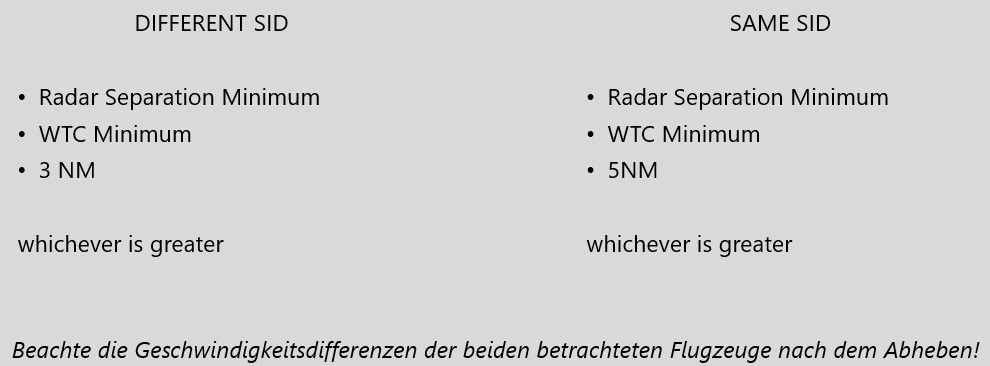](https://knowledgebase.vatsim-germany.org/uploads/images/gallery/2022-11/atd-departure-spacing.png)
**Example:** A340 ahead, C172 behind, different SID - Radar Separation Minimum? 3 NM
- WTC Minimum? 6 NM
- Spacing? 3 NM
=> WTC biggest, so minium **6 NM**
| **Beispiel:** A320 ahead, A320 behind, same SID
- Radar Separation? 3 NM
- WTC Minimum? 0 NM
- Spacing? 5 NM
=> Spacing biggest, so minium **5 NM**
|
**In general**, if you are not sure about something, always ask. Especially the colleagues on APP and CTR usually have more experience and will be happy to help you
### Inbounds
The handling of approaches for you as a tower controller can be explained quickly. You receive approaching aircraft from the approach controller approximately 8 - 12 NM before the runway. If you have approaching traffic on your frequency, you should give them clearance to land as quickly as possible. If you receive an approach and you have no departing traffic, you should give them clearance to land directly with the initial call. A pilot must have their **landing clearance at the latest before crossing the runway threshold**. If they don’t have clearance then, they will go around on their own.
The approach controller is responsible for the separation between approaches until the runway threshold is crossed. At international airports (EDDx), however, you as the tower controller may "save" the separation with the help of speed restrictions if you notice that without them, a LOS would become probable. You can also use speed instructions to maintain a gap for a VFR pilot, for example. However, it is important to coordinate speed instructions with the approach controller if there is another aircraft behind the aircraft with the assigned speed.
If two approaches are so close that there is still a risk of a loss of separation, you must instruct one of the aircraft (usually the following one) to go around **before(!)** the loss of separation occurs. In addition, traffic information about the traffic concerned can be useful. Further information on handling missed approaches can be found in the [corresponding chapter](https://knowledgebase.vatsim-germany.org/books/practical-procedures/page/missed-approach-controller-guide "Missed Approach - Controller Guide").
# Missed Approach - Controller Guide
By definition, a **missed approach** is the part of an approach procedure that is initiated if the approach cannot be continued for whatever reason. As this is a **standard procedure** and not an emergency or urgency call, every tower controller must be familiar with the handling of a missed approach.
### Reasons for a missed approach
The reasons for a missed approach are complex and can be divided into two categories: Controller-initiated missed approach and pilot-initiated missed approach.
Reasons for a missed approach **initiated by the controller** can include
- **Runway not clear**: If it must be expected that a runway will not be clear when the landing traffic crosses the runway threshold, a missed approach must be instructed **before** the aircraft crosses the runway threshold. This also applies to situations for which the controller is not responsible (e.g. runway incursion by a pilot). Exception: Reduced runway separation is applied correctly.
*[](https://knowledgebase.vatsim-germany.org/uploads/images/gallery/2023-12/pistenstu.png) Here it is predictable that CFG2TF will not be clear of the runway in time. Therefore, BAW912N must **now** be instructed to execute a missed approach.*
- **Extended centerline not clear**: At some airports (e.g. Frankfurt), certain taxiways must be clear when an inbound flies over them, otherwise the obstacle clearance is not given.
- **Separation to previous approach not guaranteed**: If it’s predictable that separation (wake turbulence separation or radar separation) to the preceeding traffic cannot be ensured and all other possible measures (speed reduction, delegating separation to the pilot, visual separation) have already been exhausted or are not practicable, a missed approach must be instructed. This must be done before the loss of separation occurs
[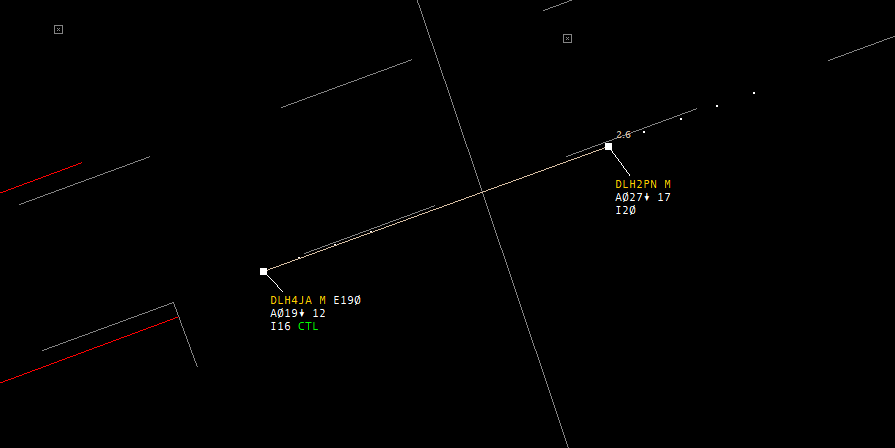](https://knowledgebase.vatsim-germany.org/uploads/images/gallery/2023-12/qxxyeifwtpahbv4jeiwqqa.png)*The minimum separation here is 2.5 NM. Currently the planes are still 2.6 NM apart. However, as the rear aircraft is 50 knots faster than the front aircraft, a loss of separation is predictable in the next few seconds. The missed approach must therefore be advised **now**.*
- **Separation to SVFR not ensured:** If loss of radar separation to an SVFR aircraft becomes probable, a missed approach must be instructed
Reasons for a missed approach **initiated by the pilot** may include:
- Unstable approach
- Missed touchdown zone
- TCAS RA (Resolution Advisory)
- Wind shear on final approach
- Thunderstorm on final approach
- Certain errors displayed in the cockpit (e.g. landing gear problems)
- No landing clearance received
### Handling of a missed approach
First of all: A controller must **assume that a pilot can perform a missed approach at any time up to and including touchdown!** Still, there must always be a plan B in the event of a missed approach.
Even in stressful situations, a missed approach should be handled calmly and professionally, according to a clear plan. The steps of this plan are now explained in detail:
##### **1. Instruct missed approach (when initiated by the controller)**
- As an instructed missed approach is usually safety-critical, the controller should raise their voice on the frequency and give a clearly audible "DLH123 go around", if necessary twice in succession.
- A reason should be given briefly and concisely (e.g. "DLH123 go around, separation not ensured" or "DLH123 go around, runway blocked").
or
##### **1. Acknowledge missed approach (when initiated by the pilot)**
- If the pilot reports a missed approach, this should be acknowledged with a "DLH123, roger". The instruction to fly the published missed approach is not necessary as it is part of the approach procedure for which the pilot has been cleared.
- The first few seconds after initiating a missed approach are very stressful in the cockpit, especially in the one-man Vatsim cockpit, so no further radio messages should be sent to the pilot. Instructions relevant to separation (see point 2) are the exception.
##### **2. If necessary, establish separation + give traffic information**
- In most cases, a pilot can fly the standard missed approach procedure and has no "opponent". However, if the missed approach brings them close to another aircraft - regardless of whether the separation is given at all times or not - **traffic information shall be given**.
- If separation from other traffic is not ensured, measures must be taken to establish separation.
- - Radar vectors ("turn away"): Upon reaching MVA, the missed approach (or, depending on the situation, other relevant traffic) may receive radar vectors, e.g. runway track, present heading or a vector to turn away. The missed approach should logically be turned away from the track of the conflicting traffic.
- Limit altitude: Sometimes it is sufficient to keep the missed approach or a departure at a certain altitude (at least MVA) to ensure separation.
- In time-critical situations and only at international airports (EDDx), the tower controller may implement these measures without prior consultation with the radar controller (separation of IFR flights is delegated to the tower there). At all other airports, separation measures must be coordinated with the APP controller, if online.
- Of course, all other traffic (other departures, VFR, traffic at the APP, etc.) must be taken into account.
[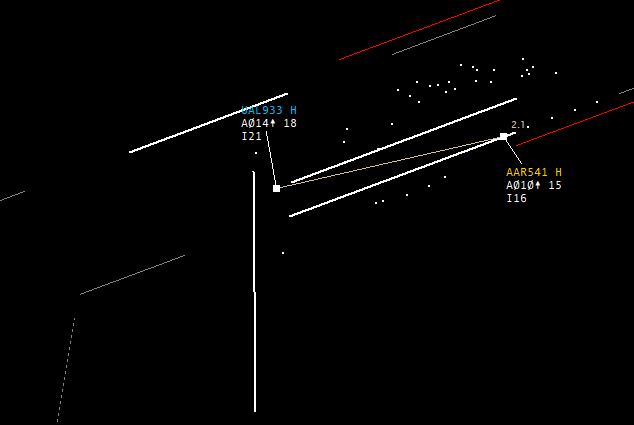](https://knowledgebase.vatsim-germany.org/uploads/images/gallery/2023-12/ga-wegdrehen.png)
*AAR541 is going around. UAL933 has just taken off and is about to turn slightly right to the northwest. To avoid entering the wakes, AAR541 should be turned to the left above the MVA (above 2100 feet) (e.g. heading 220). In addition, traffic information should be given: "AAR541, traffic, Boeing 777 just airborne runway 25C, when passing 2100 feet turn left heading 220 for separation".*
- In good weather (ceiling above the MVA), a pilot can also be turned below the MVA during the day, but only for immediate danger prevention. In this case, however, "Maintain visual reference to terrain until passing \[MVA\]" must be added. This procedure should only be used in exceptional cases
A turn below the MVA without the above mentioned addition is a serious, safety-relevant issue and will lead to a fail in exams.
##### **3. Coordination with Approach / other stations**
- Every missed approach must be coordinated with the approach controller (if online). Verbal coordination should always be preferred, as labeling the tag alone is often lost.
Example: "*Pickup North, Tower - Go ahead - Missed approach Asiana 541, Runway 25L, flying \[standard missed approach / Heading 220 due to United taking off etc.\]. I don't know the reason yet. - Roger, send him to 125.355*"
##### **4. Ask the pilot for the reason and send him off**
- If the reason for the missed approach was not obvious (e.g. not instructed by the controller), the controller should ask for it. ("DLH123, report reason for missed approach"). The reason may be relevant for other air traffic (e.g. windshears - this information should definitely be passed on to following pilots) or may be of a technical nature (e.g. problems with the engine, landing gear, etc.), as a result of which the aircraft should be given priority for the next approach or be treated as an emergency if applicable.
- As soon as the aircraft is clear of all other traffic and some time has passed since the initiation of the missed approach, the aircraft is sent away to the approach controller.
##### **5. Pass on the reason to the APP**
- As mentioned above, there can be many reasons for a missed approach which are also important for the approach controller to know. Therefore, the reason should be forwarded to the APP controller so that he does not have to ask the pilot about it again.
# Deicing using the example of EDDM
### Introduction
Aircraft are becoming more and more sophisticated and complex, there are more and more plugins that are close to reality and there is more and more interest in implementing real procedures - that's why we want to deal with the topic of "deicing" here.
First of all, this is more of an "eye opener" to shed light on this topic, which is actually very interesting but has been unfairly underappreciated. As we have to go into more detail here, the text will be a little longer.
### General
####
#### What is deicing and why is it important?
Frost, snow, ice and other contamination have a considerable influence on the aerodynamics of an aircraft. Just a few millimetres of contamination / ice on the upper surface of the wing can significantly influence and even disrupt the airflow and thus impact flight characteristics. Many aviation disasters are related to icing (just search for "aviation incidents / crashes deicing" on Google).
Deicing can be done mechanically (e.g. using a broom / shovel to remove snow from the wing surface) and chemically (i.e. with deicing fluid using deicing vehicles).
#### When do you de-ice? Only in snowy conditions, right?
There are many reasons that make deicing necessary. Very often deicing is needed even though it is not snowing at all, possibly even when the sun is shining. Here is an example: You arrive in Munich after a 6-hour flight and still have cold fuel left in the wing tanks, which are at -40°C or colder. At the turnaround you refuel for the next leg of your flight, it is +6°C in Munich and cloudy, sometimes the sun is even shining. What happens now? The warm, new fuel enters the tanks, hits the still very cold wing and a layer of clear ice forms on the top of the wing, the so-called "cold soaked wing effect" has occurred. Since, as mentioned above, contamination of the aircraft parts is not at all compatible with the aerodynamics of the aircraft, deicing can be necessary in sunny/cloudy conditions and at temperatures way above 0°C.
#### Who decides when to de-ice? Who actually de-ices? Who has the final say?
First of all, the PIC (Pilot in Command). They are responsible for the safety of the flight and so they decide whether to de-ice or not. Whether the wing is completely free of contamination and looks brand new and they still want to de-ice is up to them. Even if, as has unfortunately happened often enough, a rolling igloo taxis towards the runway, deicing is still the pilot's (...or the airline's financial situation...) decision.
However, as soon as an aircraft has registered for deicing, deicing is carried out by the respective airport operator or the handling agents. They alone then decide WHAT is de-iced on the aircraft and HOW. They are the last ones who inspect the aircraft and therefore assume liability / responsibility. They act according to the "CAC - clean aircraft concept", i.e. the aircraft must have been freed of any build-up and contamination after deicing. So even if there are only a few small snow residues on the fuselage of the aircraft, the entire fuselage (or at least parts of it) is de-iced, even if the PIC decides against it. He has no authority whatsoever (with the exception of technical backgrounds for special aircraft types / restrictions).
#### How is deicing carried out (using Munich EDDM as an example)?
A distinction is made between 1-step deicing and 2-step deicing.
In 1-step deicing, a mixture of type 1 fluid and very hot water at almost 80°C (type 1 is always orange in color) is applied to the aircraft, contamination is removed and at the same time a protective layer is applied to prevent re-icing.
In 2-step deicing, the contamination is first removed from the aircraft with type 1 and then "anti-iced" or protected in the 2nd step with type 4 fluid (cold, not heated, green in color and rather viscous).
#### What is Holdover time?
The holdover time, or HOT for short, is the period of time during which the aircraft is protected from re-icing. Depending on the type and method of deicing, the weather conditions, the type of aircraft (classically mainly aluminum, e.g. B737, or increasingly composite materials, e.g. B787), the deicing process used, etc., this can range from just a few minutes to several hours. Once the HOT has expired, there is no longer any reliable protection against contamination. Every (sensible) pilot will therefore want to de-ice again. However, the pilots themselves have leeway here and can still take off at their own discretion.
####
#### Where is deicing carried out?
In Munich, deicing takes place directly on the deicing pads/areas, which are located directly at the holding points in front of the respective runways. This concept makes Munich almost unique in the world (more on why this is so ingenious and why it is mentioned separately in a moment).
There are typically 3 deicing pads per active runway. In other words, for 08 operations, the intersections A1/A2/A3 at 08L are/can be used for deicing, and B1/B2/B3 at 08R. The holding points are simultaneously the deicing pads (08L A1 becomes deicing pad 1, A2 becomes deicing pad 2 etc. ... ) The same is true for 26 operations: Here there are A13/A14/A15 in the north which become the deicing pads DA13/DA14/DA15. In the south, simultaneously B13/B14/B15 etc turn deicing pads. Incidentally, you will find these on the ground charts as "DA14" = DeicingArea 14.
Propeller machines without prop brake are deiced in position, i.e. they receive apron deicing.
####
#### Why is deicing directly at the runway so efficient?
We learned above that the holdover time starts as soon as the deicing procedure begins. This is where the clock starts ticking. At airports with so-called apron deicing procedures, the clock starts ticking with the deicing procedure in the aircraft’s parking position. Then, the pilot still has to push, may additionally suffer a delay due to taxiing traffic and then we are looking at 10-20 minutes taxi time to the runway and possibly even more waiting time at the holding point. This time is wasted unnecessarily and minimizes our HOT.
The advantage of remote deicing (i.e. at the holding points) is that you can taxi to the CAT2/3 holding point immediately after deicing, do the engine runup (should be done after deicing) and take off directly. This minimizes time losses and the chance of having to de-ice again due to expired HOT is very small.
#### Another advantage (even if completely unnecessary on VATSIM)
In Munich, there are collecting tanks underneath ALL deicing pads. The deicing fluid / snow drains into these collecting tanks through small grooves on the deicing pad. The deicing fluid is collected, treated and can be reused, and up to 70% of deicing fluid can be completely reused. This saves a lot of money, protects the environment and the waste heat generated is used to heat an entire terminal. Pretty ingenious!
####
#### I want to de-ice! Where do I have to register?
In reality, there are many different ways to do this. Normally, pilots call in at least 20 minutes before TSAT (Target Startup Approval Time) on 121.990 Mhz (callsign "Munich Deicing Coordinator") and register there for deicing. The coordinator sees all information about the flight on their system and confirms the registration by radio. Depending on the airline, it is also possible to register for deicing via ACARS, but we are not (yet?) able to do this on VATSIM. Alternatively, you can call Tower, Ground, Delivery, Handling Agents etc. directly.
#### So how is deicing handled on VATSIM?
You call in at Delivery or the lowest position responsible for you and register for deicing in advance.
| Station | Phraseologie |
| **Pilot** | München Delivery, DLH4YA, require deicing before departure. |
| **ATC** | DLH4YA, request confirmed, you are in the sequence for deicing. |
After registering, you can push and taxi as normal and during the handover from apron to tower the tower will guide you directly to your designated deicing pad.
| Station | Phraseologie |
| **Pilot** | Tower Servus, DLH4YA, Entry S8 for deicing. |
| **ATC** | DLH4YA, servus, taxi deicing area B15 via S, on second radio contact decing crew on XXX,XXX Mhz, report deicing completed. |
(If, out of boredom, an ATC were to join the frequency and simulate the deicing crew for fun)
Everything else is simply improvised and simulated, that's all that's technically possible at the moment ;-) Here is an excerpt from the official document on deicing at Munich Airport, including the course of the conversation:
[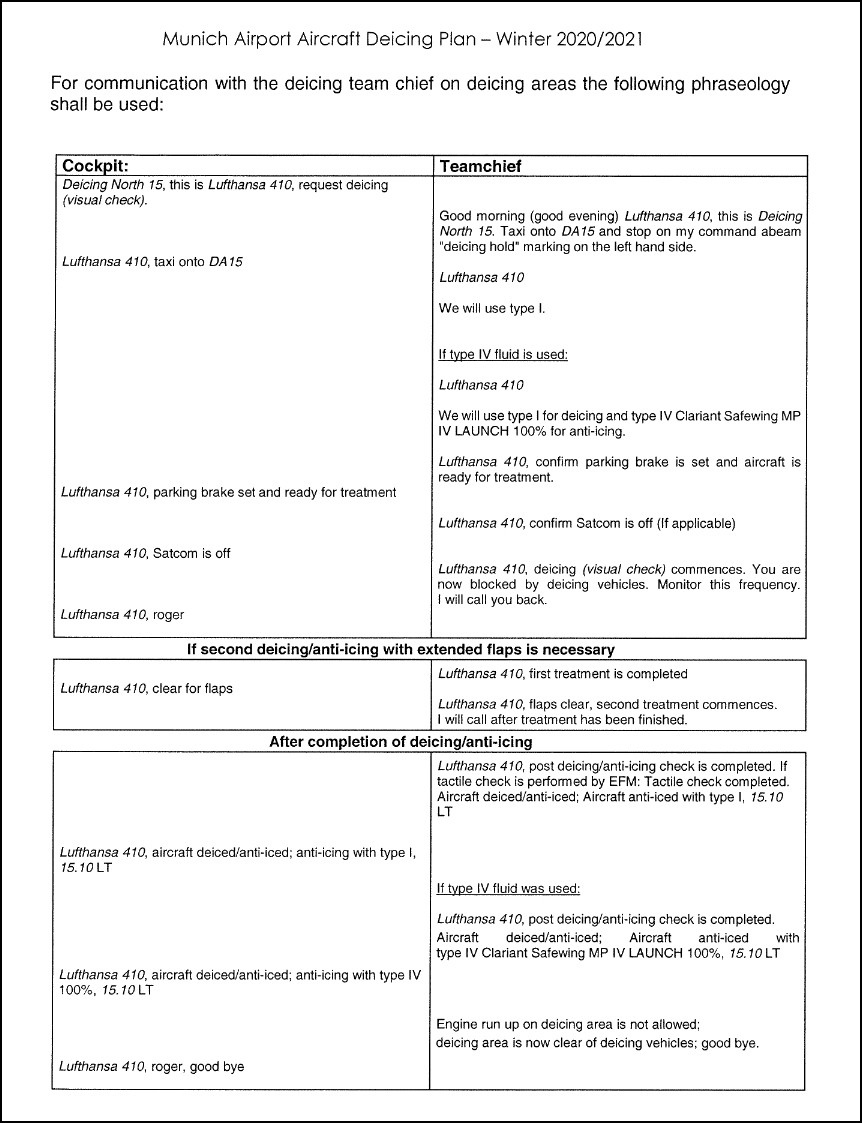](https://knowledgebase.vatsim-germany.org/uploads/images/gallery/2022-10/edmm-deicing-communication.jpg)
### Crash course on METAR vs. HoldoverTime
Using the following example, I would like to briefly and roughly outline how to select the HOT / deicing variation from the tables using the current METAR information. I'll try to keep this extra short, so I won't cover every footnote or all the details:
We have the following METAR:
1820Z EDDM 26015KT 2000 -SN BKN006 OVC020 M02/M04
In short (and only very roughly!), weather report from 18:20 Zulu (i.e. in the evening), from Munich, wind from 260 degrees at 15 knots, 2000m visibility RVR, light snowfall, cloud cover at lower limit 600 ft, closed cloud cover lower limit 2000 ft, temperature -2°C, dew point -4°C.
Now I already know we don't have "active frost" alone where we can only deice / anti-ice 1 step with type 1, but we have evening / darkness, low visibility due to snowfall and sub-zero temperatures.
Since we only have RVR values (in real life we use the MOR meteorological observation range), we go directly to Table 42: SNOWFALL INTENSITIES AS A FUNCTION OF PREVAILING VISIBILITY. We know it is evening, so we go to the left column under "Night". We also know it is currently -2 degrees, so we go to the "colder/equal -1" column.
[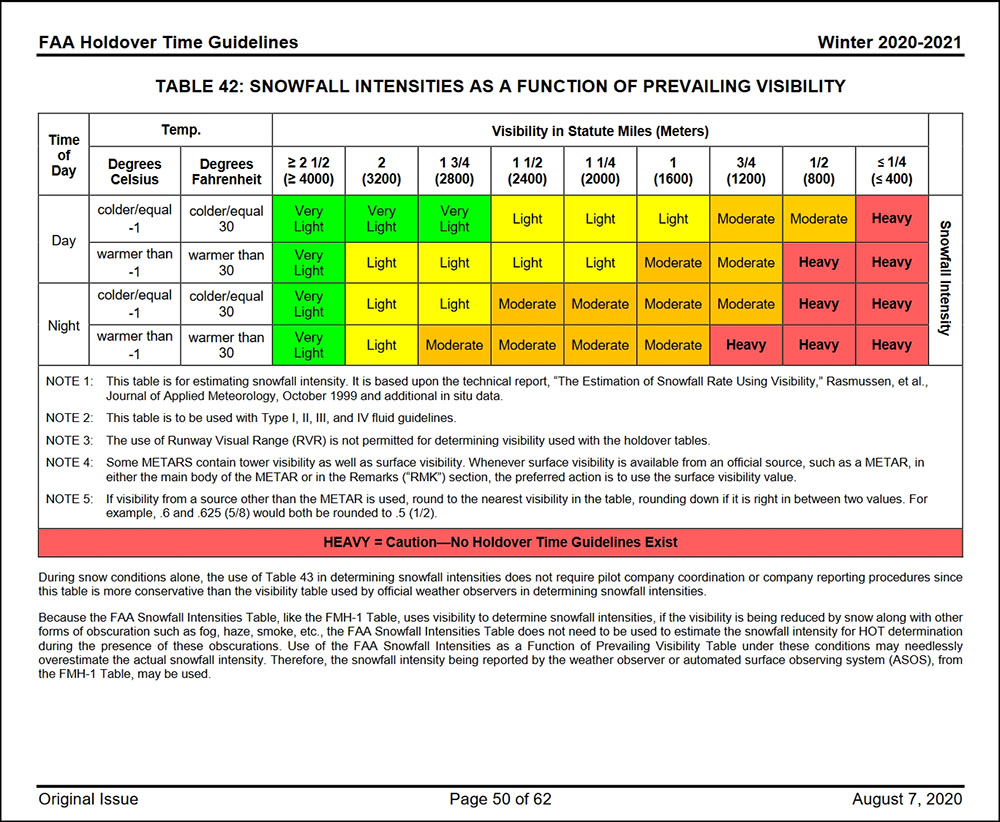](https://knowledgebase.vatsim-germany.org/uploads/images/gallery/2022-10/edmm-deicing-vischart.jpg)
Now we take the reported visibility of 2000 m and look at the top of the column where we have to position ourselves. In our case at 1 1/4 (2000). Well, one finger to the left, one finger from above, put the two together and we end up with the value "MODERATE". Quite simple, isn't it?
With this "MODERATE" value in mind, we now go over to Table 27: Type IV HOLDOVER TIMES FOR CLARIANT SAFEWING MP IV LAUNCH (This is the deicing fluid type 4 with a concentration of 100%, which the deicing coordinator told us is what they used).
[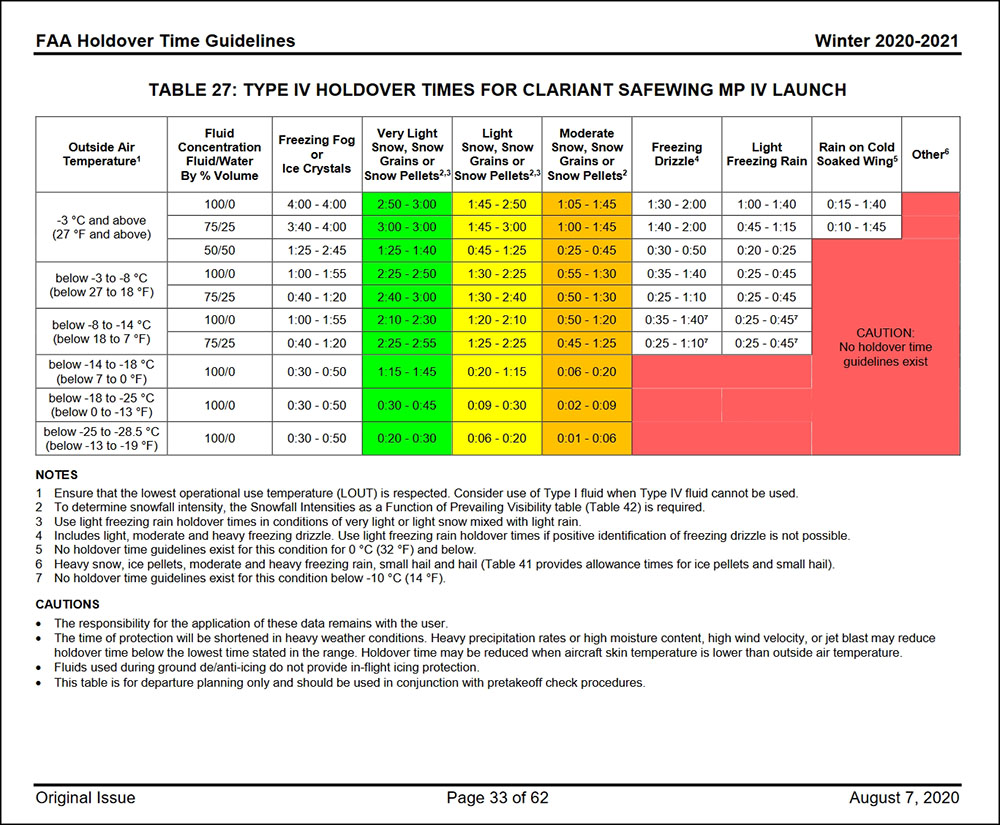](https://knowledgebase.vatsim-germany.org/uploads/images/gallery/2022-10/edmm-deicing-hottyp-4.jpg)
Now we continue as before: We know in the left column at "Outside Air Temperature" we have 2°C, ergo we are at "-3°C and above". We also know that the concentration is 100% type 4, so we go to "100/0" in the column.
We have previously picked out the visibility and the respective value, which was "MODERATE" and slide into the respective column to "MODERATE SNOW; SNOW GRAINS OR SNOW PELLETS"..... and get a value of 1:05 - 1:45. This means that as soon as the anticing starts, i.e. the first contact with type 4 on the aircraft, we now have a holdover time of between 1h:05 min and 1h:45 min. This will get you out of ATC pretty reliably and you still have a good time buffer. So it wasn't that difficult after all ;-)
I have attached the tables, if you want to read a bit yourself just search for the "FAA2020-2021 Holdover Tables".
This should give you a rough insight into the world of de-icing, why it is so important, what is behind it, how it roughly works and what approximate processes are behind it. Xplane, FSLabs and the Majestic Dash Q400 already simulate icing, GSX and Co. allow you to de-ice yourself and the developers of aircraft are picking up this topic more and more.
We (RG Munich) are always happy to answer any queries, suggestions, technical questions or discussions! This thread may be expanded if necessary. Spelling mistakes and other errors can be collected and exchanged for an ice cream.
### Epilog
This article was created by Florian Weingartner, RG Munich, who kindly agreed to transfer it to the Wiki.
# Low Visibility Operations (LVO)
The correct use of LVO is not a mandatory part of S1 training.
#### Introduction
In normal operations, pilots fly an ILS approach up to the so-called CAT1 minimum which usually sits 200ft above the runway threshold. Not later than at the minimum, the crew must have certain runway markings or the runway lighting in sight in order to be able to continue the approach. If this is not the case at the minimum, the aircraft must go around. ILS (and more recently also GLS/GBAS) CAT2 and CAT3 approaches are therefore available for poor weather conditions. In order for these to be carried out, the aircraft requires certain equipment (e.g. a radio altimeter), the crew must be trained and approved for this and the airfield must have a correspondingly precise and approved ILS system. In addition, the provision of CAT2 and CAT3 procedures requires certain operational procedures on the part of air traffic control and the aerodrome operator. These are explained in the following chapters. If CAT 2/3 procedures are activated, this is referred to as **Low Visibility Operations (LVO)** or **Low Visibility Procedures (LVP)**.
#### Requirements and activation
LVPs are active as soon as one of the following two criteria is met
- Ceiling < 200 feet
- Runway visual range (RVR) <= 600 meters
The ceiling is the lowest cloud base with a coverage of more than 50%, i.e. BKN or OVC. Sometimes no cloud base can be measured (e.g. due to dense fog). In this case, the vertical visibility is used. This is given in the format VVxxx. Here are a few examples:
- VV010 = vertical visibility 1000 feet
- VV002 = vertical visibility 200 feet
- VV/// = Vertical visibility not measurable. This value is to be interpreted as vertical visibility less than 100 feet
The runway visual range is a value determined by a measuring system that differs from the ground visibility determined by a weather observer. In terms of horizontal visibility, only the RVR is relevant for the provision of LVOs. Further information on RVR can be found [here](https://en.wikipedia.org/wiki/Runway_visual_range).
The following rules apply to airports with several runways: LVOs always affect the entire airfield. Even if the RVR is well over 600 meters on one runway but 550 meters on the other, Low Visibility Procedures apply to all runways and taxiways.
#### Measures for LVO
##### Switch ATIS
Pilots are informed about Low Visibility Operations via ATIS (LOW VISIBILITY PROCEDURES IN OPERATION CAT II AND III AVAILABLE). Without this information (or other agreements), pilots are not permitted to carry out approaches with minima of less than 200 feet. To transmit this information in ATIS, the suffix &lvp must be added to the ATIS Maker URL (the suffix may vary depending on the regional group and airfield). Further information on the subject of [ATIS](https://knowledgebase.vatsim-germany.org/books/meteorology/page/atis "ATIS") can be found in the knowledgebase article of the same name and in particular in the FIR-ATIS articles linked there.
##### Clear only up to CAT 2/3 holding points
Both the localizer and the glideslope signal are electromagnetic waves in the MHz range and are therefore subject to the physical phenomena of interference and reflection. The signals can be altered by sources of interference, resulting in so-called bends or scalloping. For CAT1 approaches, pilots can visually detect possible major inaccuracies in the signal below the minimum and then initiate a missed approach or manually correct the approach and land. This is not possible for CAT2/3 approaches, which may not have a minimum at all. Sources of interference must therefore be eliminated where possible.
As large metallic objects, aircraft on the runway are also sources of interference. Accordingly, they must have a certain distance from the runway in order to keep the ILS signal as precise as possible. This particularly sensitive area around the runway is called the "sensitive area" and must be free of obstacles and sources of interference.
The "normal" CAT 1 holding points lie within this area, which is why other holding points are necessary for LVPs. These are the so-called CAT 2 holding points. On ground radar maps, you will generally find two holding points at the takeoff intersections. The CAT 1 holding point is closer to the runway, the CAT 2 holding point a little further away.
Accordingly, the following phrase must be used on the radio when clearing to the holding point: *"DLH414, TAXI TO **CAT II HOLDING POINT** RUNWAY 26R via N A15".*
Correspondingly, during LVP the runway is only considered vacated by an arriving aircraft when the aircraft is completely behind the CAT 2/3 holding point. Otherwise the runway is not considered clear in terms of separation.
At some airports, the Landing Clearance Line (LCL) procedure is permitted. In this case, the runway is considered cleared when the aircraft has completely overrun the so-called landing clearance line (usually located 102 m from the center of the runway). This procedure is sometimes even more restricted (e.g. only for WTC M or L). Details on whether the procedure is permitted at your airfield, where the landing clearance line is located and how to work with it can be found in the SOP of your training airport.
Important: Depending on the SOP of the respective airport the sensitive area must be clear when the next approach reaches the 2-mile final approach. If the sensitive area is not clear when the following approach is at 2 miles, the approaching aircraft must be instructed to go around. When using the Landing Clearance Line procedure, the Landing Clearance Line must be crossed before the following approach is at 0.6 NM final approach or 200ft AGL. Whether these procedures are used on Vatsim can be found in the respective tower SOPs.
##### Tell the RVR
Not every RVR allows for legal landings. This depends on various factors. These include the certification of the airline, the aircraft, the crew, but also the type of approach. In order for a pilot to know whether he is currently still allowed to land, he must receive the latest RVR at two points in time:
- At the approach clearance (by the approach controller): "DLH123, cleared ILS approach runway 25L, RVR 800 meters"
- Before the 4 NM final approach again (can also be given with the landing clearance): "DLH123, RVR runway 25L 600 meters, wind 210 degrees, 4 knots, runway 25L cleared to land"
As there is no source for live RVRs on VATSIM, the RVR is read out of the METAR instead. Sometimes it is also possible that there is only one RVR for the opposite direction (e.g. 08R instead of 26L) in the METAR. This is then used. If there is no RVR at all in the METAR for a particular runway, it can be assumed that the RVR is greater than 2,000 meters.
##### Discontinuation of certain procedures
Some procedures depend on aircrafts’ visual contact or that the tower controller sees the aircraft from his window. We also simulate this on Vatsim in good weather. However, at least under LVO, the visibility is so poor that the following procedures are no longer permitted:
- Conditional line-ups
- Multiple line-ups
- Reduced runway separation (limits are already higher)
- VFR / SVFR (limits are already higher) - exception: pilot confirms that he is simulating VMC
- Visual separation in the vicinity of aerodromes
- Taxiing on unlit taxiways (if explained in the airport's SOPs)
Furthermore, instructions such as "Expedite taxi" or "Expedite vacating the runway" should be avoided, as it is generally not possible for the pilot to taxi faster due to poor visibility.